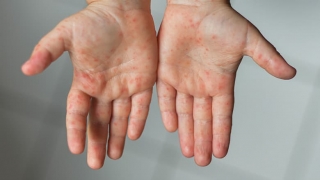What to Do if Your Child Has Hand, Foot and Mouth Disease
Published on
Health Tip of the WeekPublished on
Health Tip of the Week It’s important to be on the lookout for hand, foot and mouth disease, a common childhood illness most often seen in the summer and fall. No, it is not the foot and mouth disease that affects animals — this one gets its name from a distinctive rash that appears on the hands, on the feet and in the mouth.
It’s important to be on the lookout for hand, foot and mouth disease, a common childhood illness most often seen in the summer and fall. No, it is not the foot and mouth disease that affects animals — this one gets its name from a distinctive rash that appears on the hands, on the feet and in the mouth.
The rash manifests as tiny red bumps or blisters on the palms of the hands, soles of the feet, fingers and toes. In the mouth, the rash appears as painful sores or ulcers mainly clustered in the back of the throat. But the rash does not necessarily appear in all three areas, and can appear on the arms and legs as well as on the buttocks.
In addition to rashes, children often have a fever for the first few days of the illness. Some also have loose stools. Although the skin rash can be a slightly tender nuisance, the mouth sores can be so painful that children refuse to eat or drink.
While there is no specific cure for hand, foot and mouth disease, you can keep your child comfortable until the illness resolves by following these tips:
The worst of the mouth pain typically occurs during the first three to five days of illness. Antibiotics and other medications do not kill this virus.
The coxsackie virus that causes hand, foot, and mouth disease is mainly spread through saliva and stool. This is why it often affects toddlers: Kids in this age group often touch other children or share toys and then put their hands in their mouths. The best way to limit the spread of the virus is through frequent handwashing.
Adults can get hand, foot and mouth disease too, so you should also wash your hands frequently, both while caring for your child and after changing diapers.
Like most childhood viruses, it is difficult to pinpoint exactly when kids with hand, foot and mouth disease are no longer contagious. We do know that children can spread hand, foot and mouth disease starting the day before the rash shows up and for several days after the rash appears.
As long as children do not have a fever and otherwise are acting like themselves, most child care centers do not exclude children with the assumption that good handwashing is routinely practiced.
Most of the time, children do well with this virus. Not all children have pain, and the rash needs no treatment. Keep children home from school until their fever and pain resolve. They do not have to stay home until the rash resolves, which can take one to two weeks.
Call your child’s healthcare provider if:
Contributed by: Julie Kardos, MD, FAAP, Naline Lai, MD, FAAP
Categories: Weekly Health Tips, Childhood Diseases
Are you looking for advice to keep your child healthy and happy? Do you have questions about common childhood illnesses and injuries? Subscribe to our Health Tips newsletter to receive health and wellness tips from the pediatric experts at Children's Hospital of Philadelphia, straight to your inbox. Read some recent tips.